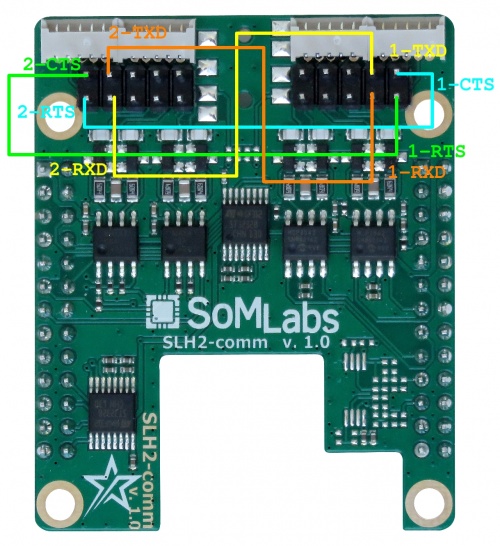StarSBC-6ULL RS232 example: Difference between revisions
From SomLabs Wiki
Created page with "{{PageHeader|StarSBC-6ULL RS232 example}} __toc__ This tutorial shows how to send and receive data using RS232 interface on StarSBC-6ULL with communication extension board. T..." |
|||
| (4 intermediate revisions by 2 users not shown) | |||
| Line 1: | Line 1: | ||
{{PageHeader|StarSBC-6ULL RS232 example}} __toc__ | {{PageHeader|StarSBC-6ULL RS232 example}} __toc__ | ||
This tutorial shows how to send and receive data using RS232 interface on StarSBC-6ULL with communication extension board. The default Yocto image | This tutorial shows how to send and receive data using RS232 interface on StarSBC-6ULL with communication extension board SLH2-comm. The default Yocto image contains all required software tools. | ||
=== Loop test === | === Loop test === | ||
The extension board has two RS232 interfaces available so they may be connected to perform the test in a loop. All signals are available on the J101 and J201 connectors. They should be connected according to the following table: | The SLH2-comm extension board has two RS232 interfaces available so they may be connected to perform the test in a loop. All signals are available on the J101 and J201 connectors. They should be connected according to the following table: | ||
{| class="wikitable" | {| class="wikitable" | ||
| Line 24: | Line 24: | ||
| RS232-2 CTS (J201 pin 9) | | RS232-2 CTS (J201 pin 9) | ||
|} | |} | ||
[[File:StarSBC-6ULL-SLH2-rs232.jpg|center|500px]] | |||
Both interfaces are already defined in the default module device-tree and are recognized as /dev/ttymxc2 and /dev/ttymxc6 devices. The device files may be used directly for reading and writing and the bitrate may be set using the stty tool: | Both interfaces are already defined in the default module device-tree and are recognized as /dev/ttymxc2 and /dev/ttymxc6 devices. The device files may be used directly for reading and writing and the bitrate may be set using the stty tool: | ||
Latest revision as of 08:58, 13 December 2022
StarSBC-6ULL RS232 example
This tutorial shows how to send and receive data using RS232 interface on StarSBC-6ULL with communication extension board SLH2-comm. The default Yocto image contains all required software tools.
Loop test
The SLH2-comm extension board has two RS232 interfaces available so they may be connected to perform the test in a loop. All signals are available on the J101 and J201 connectors. They should be connected according to the following table:
| RS232-1 signal | RS232-2 signal |
|---|---|
| RS232-1 TXD (J101 pin 3) | RS232-2 RXD (J201 pin 8) |
| RS232-1 RXD (J101 pin 4) | RS232-2 TXD (J201 pin 7) |
| RS232-1 CTS (J101 pin 1) | RS232-2 RTS (J201 pin 10) |
| RS232-1 RTS (J101 pin 2) | RS232-2 CTS (J201 pin 9) |

Both interfaces are already defined in the default module device-tree and are recognized as /dev/ttymxc2 and /dev/ttymxc6 devices. The device files may be used directly for reading and writing and the bitrate may be set using the stty tool:
root@starsbc-6ull:~# stty -F /dev/ttymxc2 9600 crtscts root@starsbc-6ull:~# stty -F /dev/ttymxc6 9600 crtscts root@starsbc-6ull:~# cat /dev/ttymxc2 & [1] 465 root@starsbc-6ull:~# echo "123" > /dev/ttymxc6 123